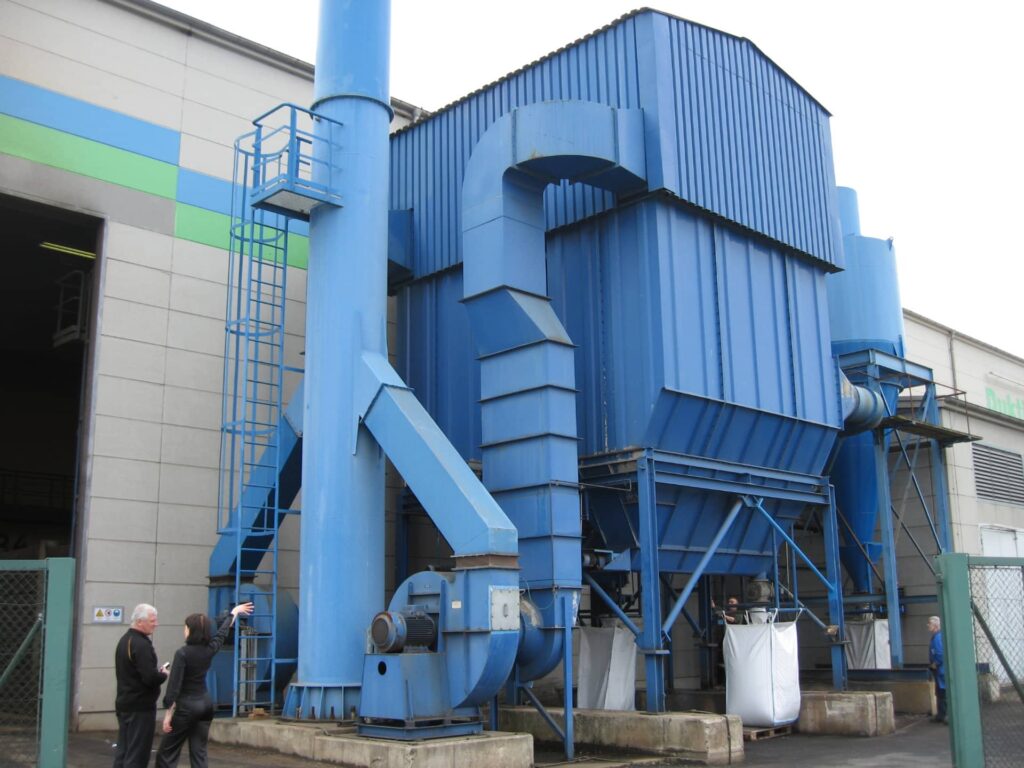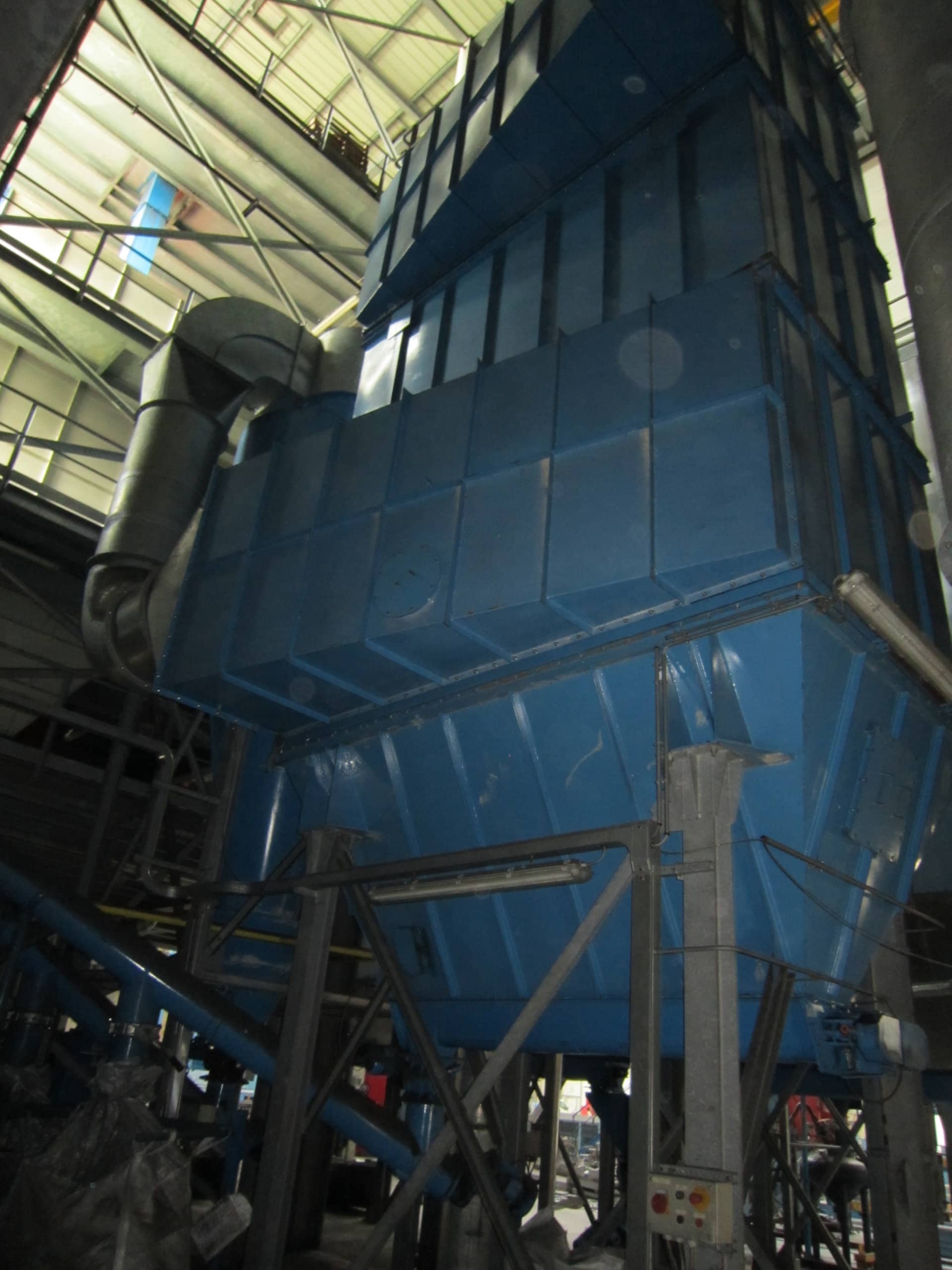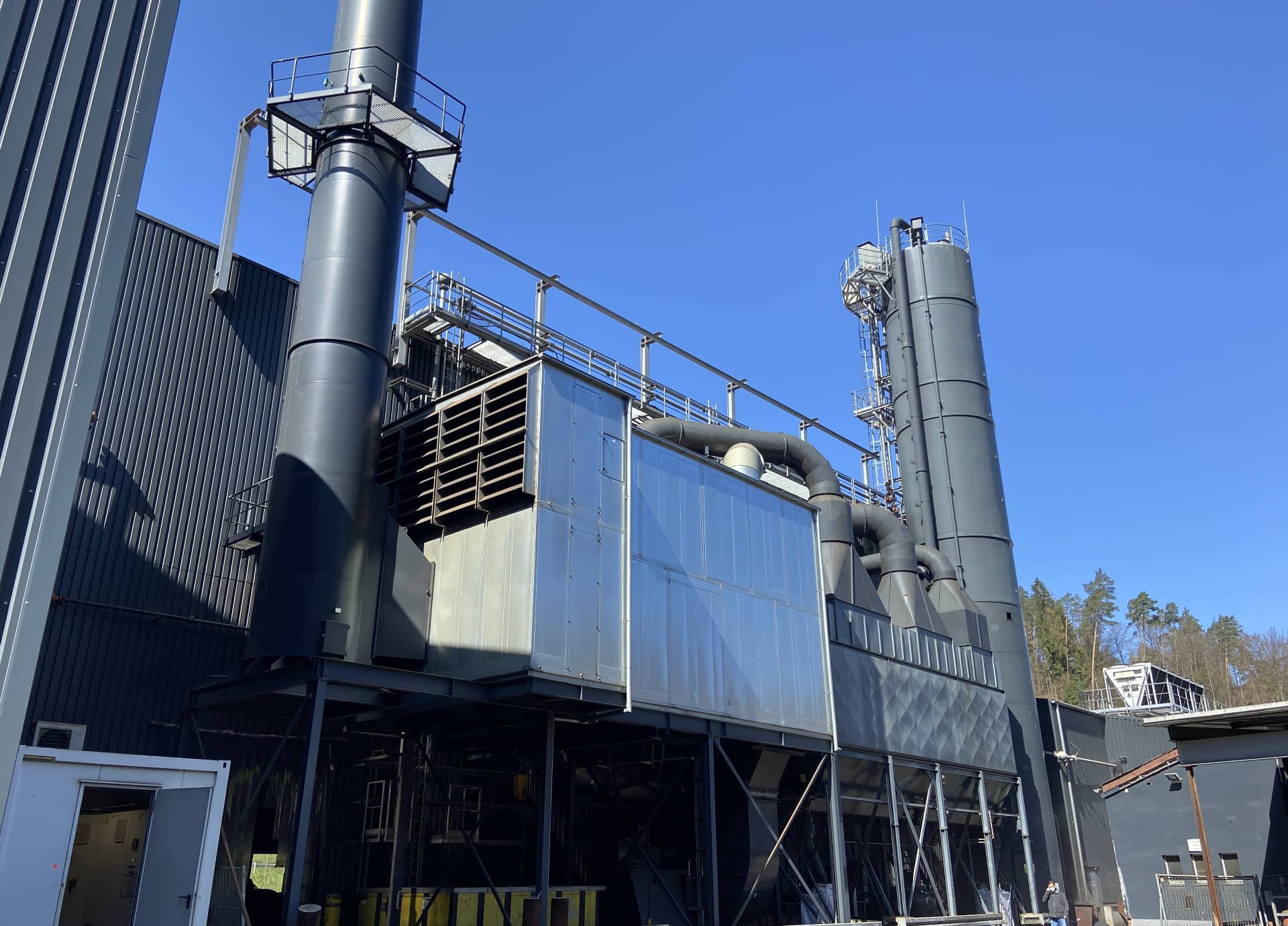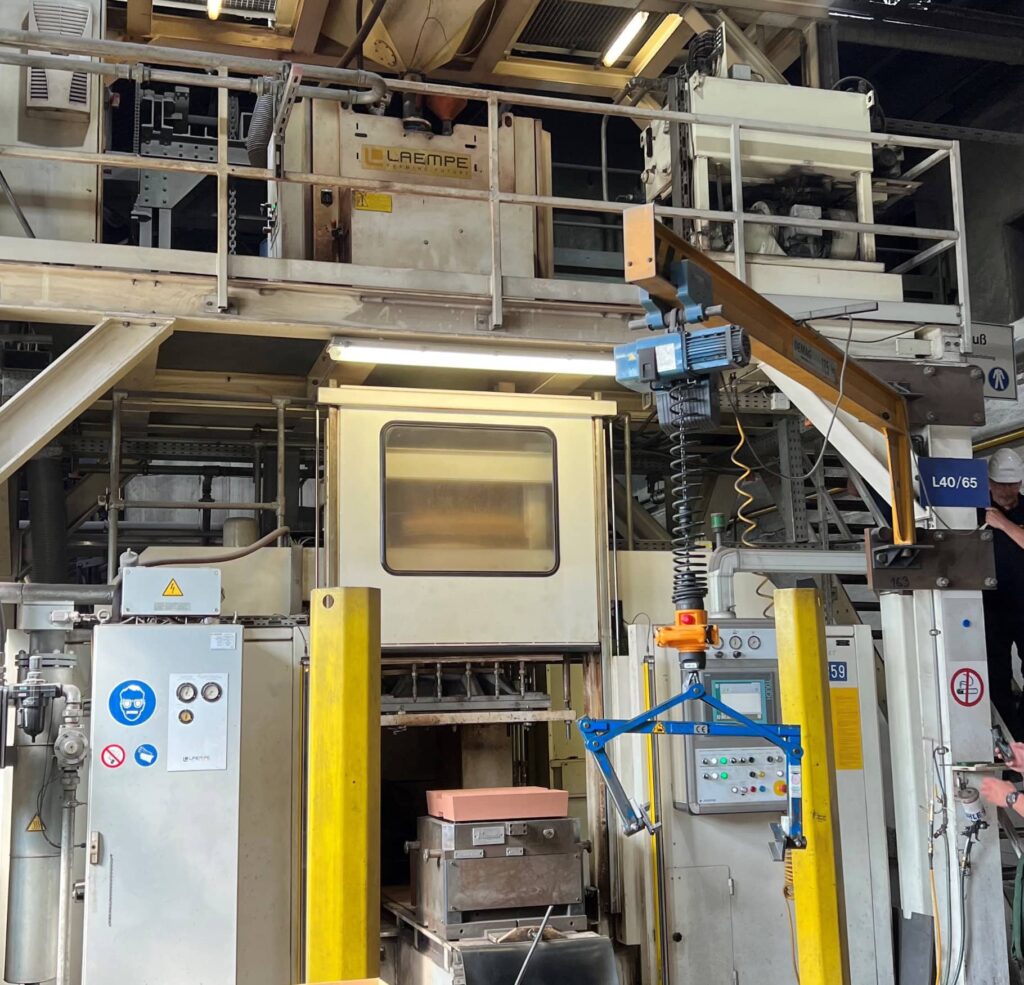Used dedusting systems for foundries
Dust extraction systems play a crucial role in foundries. They are used to comply with legal emission limits, ensure occupational safety and create a clean production environment. Foundry processes generate large quantities of dust and smoke – for example from melting furnaces, handling moulding sand, knocking out castings or the use of blasting systems. Without effective dust extraction, these particles would heavily pollute the air in the hall and cause health problems.
High-performance industrial filter systems are therefore a must in every foundry. They capture harmful fine dusts (e.. quartz dust or metal oxides) before they enter the air we breathe. This protects employees from lung diseases and keeps emissions below prescribed limits. This is important in order to fulfil official requirements and avoid penalties. At the same time, effective extraction ensures that less dust settles on machines and products. This increases the reliability of the systems and improves the quality of the cast parts.

Dedusting systems
References - Successfully brokered second-hand dust extraction systems
As an experienced partner, we have already successfully brokered numerous dedusting systems. Some examples from our references:
- LÜHR - Bag filter system approx. 10,000 m³/h - conveyed in Germany in 2021 (compliance with strict emission requirements in an iron foundry).
- Nederman - filter system 195,000 m³/h - sold within Germany in 2021 (large central extraction system for an automotive supplier).
- Nederman - filter system 70,000 m³/h - sold to Hungary in 2022 (complete dedusting system for a foundry expansion in Eastern Europe).
- AREA Impianti - filter system approx. 50,000 m³/h - sold to Serbia in 2016 (Italian dedusting technology for a steel foundry).
Further references available on request – we have successfully brokered investments worldwide in Europe, Asia, Africa and America.

Dedusting systems manufacturers & models
Established manufacturers of dedusting systems for foundries and examples of their well-known models/series:
LÜHR
Bag filter systems (e.. WMF series, modular design)
Dantherm
Jet pulse filter systems (formerly Dantherm Filtration, now Nederman)
AREA Impianti
Large filter systems for foundry dust (Italian supplier)
BMD
Dedusting components in BMD foundry lines (integrated solutions)
Nederman
Cartridge and bag filter systems (used worldwide)
Note: Not all models mentioned are always in stock. However, thanks to our international network and customer searches, we can find and your desired machine in a targeted manner.

Related categories
Used technology is also used in other areas of the foundry. Discover other categories in our range of machinery:
- Sand preparation: Used equipment for the preparation of moulding sand (sand mixers, cooling drums, etc.).
- Moulding plants: Moulding technology (boxless moulding plants, moulding machines) for mould casting.
- Melting furnaces: Melting shop equipment (induction furnaces, crucible furnaces and other melting equipment).
- Core making: machines for core production (e.. automatic core shooters and sand mixers for core sand).
- Finishing shop: Machines for post-treatment of castings (overhead conveyor blasting systems, grinding machines and deburring systems).

Advantages of used dedusting systems
Why should you opt for a used dust extraction system? The purchase of used systems offers a number of advantages:
- Immediate availability: Used systems are generally available immediately, without the months-long production and delivery times associated with new systems. This means shorter project times and a faster start to production.
- Cost savings: The purchase price is significantly lower than that of a new machine. Buying a used foundry machine is often an economically interesting alternative to buying a new one . You save on investment costs and protect your budget.
- Proven technology: A used dedusting system has already proven itself in everyday production. Teething troubles have usually been eradicated and reliability is tried and tested. You know what you are getting and can rely on the operating history.
- Faster amortisation: The system pays for itself more quickly due to the lower investment costs. The return on investment (ROI) phase is shorter, as savings have been made on the acquisition costs.
- Sustainability: The reuse of used machines conserves resources and is sustainable. Instead of scrapping a fully functional machine, it continues to be used – this saves raw materials and energy and reduces the need for new production.
- Flexibility & customisation: Used dedusting systems can be retrofitted or adapted as required. Performance can be further optimised through updates (e.. more modern filter media or control systems). Many machines can be adapted to new requirements or higher capacities by our specialists.
FAQ
When buying, you should pay attention to the performance and size of the system – does the volume flow (m³/h) match your requirements and the size of your foundry? Check the condition of the filter system: Are the filter elements still in good condition or will they need replacing soon? How old is the system and is there documentation (operating instructions, maintenance records)? It is also important to check whether the system is complete (fan, control unit, chimney, etc.) and has been dismantled in working order. Ideally, you should buy from a specialised dealer such as TCT Tesic, who will check the machines in advance and inform you honestly about their condition and any overhaul requirements. This will ensure that the dust extraction system meets your requirements and is delivered ready for immediate use.
In principle, used dust extraction systems can also comply with the statutory emission limits, provided they are correctly designed and maintained. In many cases, older systems still achieve very low dust values in the exhaust air. However, you should check whether retrofitting may be necessary in order to fulfil new regulations – e.. the use of more efficient filter media or modern measurement and control technology. TCT Tesic can advise you on this and, if necessary, upgrade filter systems so that you can safely fulfil all current requirements (such the limit values of TA Luft in Germany). It is also important to carry out an emission measurement after installation in order to provide official proof of compliance with the values.
This depends on the regional regulations. In Germany, dedusting systems are part of the overall system of a foundry that requires authorisation. If a used filter system is newly commissioned or installed at a different location, this must generally be reported to or approved by the supervisory authority (e.. the environmental agency). Formal acceptance on site may be necessary, especially if the system has undergone significant changes or must be equipped with explosion protection devices (ATEX), for example. We recommend involving the authorities at an early stage. If required, TCT Tesic supports its customers with the necessary documentation (technical data, drawings, test certificates) and works together with experts to ensure a smooth acceptance procedure. After successful commissioning, the emissions can be measured by a certified institute and submitted to the authorities.
Yes – TCT Tesic offers a comprehensive service for used foundry systems. We support you right from the dismantling of the dedusting system at the seller’s premises. Our external partners take care of the professional deinstallation, labelling and packaging of all components. We then organise the transport (by lorry, container or ship, depending on the distance) to your site. On site, we take care of the installation of the system in your foundry and support you during commissioning. We check whether all interfaces are correct (e.. connection to existing pipework and power supply) and make fine adjustments to the control system. You will also receive instruction on how to operate the system. In short: We don’t leave you on your own – TCT Tesic is at your side from the collection to the operational handover of your used dedusting system.
Dust extraction systems are low-maintenance, but require regular care in order to work efficiently in the long term. Regular filter changes are important: depending on the operating hours and the amount of dust, filter bags or cartridges must be replaced after a few years. Many systems monitor the filter status via differential pressure – if this rises sharply, it needs to be replaced. The fan should also be serviced (check bearings, V-belt or coupling, clean fan blades to remove deposits). The cleaning device (compressed air valves, control unit) must be checked occasionally to ensure that it is working properly and that the dust cake is reliably removed. The dust collection containers must also be emptied regularly before they are full. As part of the annual maintenance, it is advisable to check the entire system for leaks – especially the seals on the filter housing and the inspection flaps. TCT provides trained specialists to ensure that your dust extraction system remains in top condition for the long term.
Yes, in many cases used dust extraction systems can be customised. If the performance is not quite sufficient, the extraction performance can be increased by installing a more powerful fan or additional filter modules, for . It is also possible to modernise the control system – modern control systems offer, for , more efficient control of the fan (keyword: frequency converter) or more convenient monitoring via touch panel and remote diagnostics.
About TCT Tesic
TCT Tesic GmbH is one of the leading international dealers and service providers for used foundry equipment – including dedusting technology, of course. For decades, TCT Tesic has been supporting foundries worldwide in the purchase and sale of used machinery. The company, based in Iserlohn (Germany), operates globally and offers its customers an all-round carefree package: from the initial consultation and inspection of a system to dismantling at the seller’s premises, transport logistics and reassembly at the buyer’s premises, through to support with commissioning on site. TCT Tesic also has almost 10,000 m² of storage capacity for the temporary storage and handling of large systems . This comprehensive range of services – including worldwide dismantling and assembly, professional packaging, customs clearance and transport – even enables complete foundries to be relocated to new sites. Thanks to direct contacts with foundries and an international network, TCT Tesic can quickly find suitable buyers or sellers. Customers benefit from personalised advice, a high level of technical expertise and an experienced team that successfully implements projects of any size.
Design and operation of dust extraction systems in foundries
A typical dedusting system for foundries consists of several central components that work together to ensure effective dust separation:
- Capture system: Special extraction bonnets and pipes capture the dust-laden air directly at the source – for example at the oven tapping point, the moulding system or the blasting system. The dust is channelled to the filter unit via these pipes.
- Filter housing with filter media: The filter elements (usually filter bags made of fabric or filter cartridges) are located in the filter housing. The dust-laden air flows through the filter media, whereby the dust particles are retained. They are deposited as a layer of dust (filter cake) on the outside of the filter bags or cartridges, while the cleaned air passes inside.
- Cleaning system: To ensure that the filters remain permanently permeable, dust extraction systems have an automatic cleaning system. For example, a short pulse of compressed air is passed through the filter bags at regular intervals during pressure surge cleaning. This briefly inflates the bags and the accumulated dust cake falls off. The cleaned dust collects in funnels or collection containers under the filter and can be disposed of from there.
- Fan: A powerful fan generates the necessary negative pressure to draw the air through the entire system. It is typically positioned behind the filter so that only cleaned air flows through the fan – this protects the fan unit from abrasion caused by coarse particles. The fan largely determines the extraction performance (volume flow in m³/h) of the system.
- Chimney/exhaust air duct: The cleaned air is then released into the atmosphere via a high chimney or an exhaust air duct. The chimney ensures that the residual emissions are diluted over a wide area and contributes to the fact that hardly any dust can be measured on the ground. Modern systems thus fall well below the required emission values.
- Control unit: An electronic control unit monitors and regulates the dust extraction system. Sensors (e.. differential pressure gauges) monitor the filter status and signal when the filters need to be cleaned or replaced. The control unit automatically switches the cleaning process on and off and can regulate the fan as required. Safety functions – such as an alarm in the event of a filter rupture or switch-off in the event of a failure – are also integrated here.
Functional principle: During operation, the dust-laden air is collected at the extraction bonnets and sucked through the filter system by the fan. The filter media reliably separates the dust particles so that almost only clean air passes through the filter. The cleaned air then flows through the fan and is discharged to the outside via the chimney. The separated dust is collected in collection containers and regularly disposed of or fed back into the production cycle (e.. recovery of moulding sand). Modern dedusting systems achieve separation efficiencies of over 99 % – often only a few mg of dust per m³ remain in the exhaust air, well below the permissible limit values.
Newsletter & Machine service
Whether you want to buy a used machine or have a machine to sell, we are here to help and advise you.
- Subscribe to our newsletter: Stay up to date with new machine offers and exclusive promotions. Don’t miss out on any opportunities and sign up now.
- Request a machine: Have you seen a suitable machine or do you have specific requirements? Submit your machine request today. We will find the optimal solution for you and get back to you as soon as possible.
- Sell machine: Do you own a core shooting machine that you would like to sell? You’ve come to the right place. Contact us and we will help you sell your core shooting machine – quickly, reliably, and at the best possible price.
TCT Tesic – your partner for comprehensive foundry services. We look forward to your inquiry!

If you have any further questions, please do not hesitate to contact us or use our contact form.
